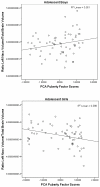Pubertal status associations with reward and threat sensitivities and subcortical brain volumes during adolescence
- PMID: 24512818
- PMCID: PMC4125562
- DOI: 10.1016/j.bandc.2014.01.007
Pubertal status associations with reward and threat sensitivities and subcortical brain volumes during adolescence
Abstract
Adolescence is characterized by complex developmental processes that impact behavior, biology, and social functioning. Two such adolescence-specific processes are puberty and increases in reward sensitivity. Relations between these processes are poorly understood. The present study focused on examining unique effects of puberty, age, and sex on reward and threat sensitivities and volumes of subcortical brain structures relevant for reward/threat processing in a healthy sample of 9-18year-olds. Unlike age, pubertal status had a significant unique positive relationship with reward sensitivity. In addition, there was a trend for adolescent females to exhibit higher threat sensitivity with more advanced pubertal development and higher reward and threat sensitivity with older age. Similarly, there were significant puberty by sex interaction effects on striatal volumes, i.e., left nucleus accumbens and right pallidum. The present pattern of results suggests that pubertal development, independent of chronological age, is uniquely associated with reward hypersensitivity and with structural differences in striatal regions implicated in reward processing.
Keywords: Adolescence; Behavioral approach system (BAS); Behavioral inhibition system (BIS); Puberty; Reward sensitivity.
Copyright © 2014 Elsevier Inc. All rights reserved.
Figures

Similar articles
-
Neural systems underlying reward cue processing in early adolescence: The role of puberty and pubertal hormones.Psychoneuroendocrinology. 2019 Apr;102:281-291. doi: 10.1016/j.psyneuen.2018.12.016. Epub 2018 Dec 13. Psychoneuroendocrinology. 2019. PMID: 30639923 Free PMC article.
-
Unraveling age, puberty and testosterone effects on subcortical brain development across adolescence.Psychoneuroendocrinology. 2018 May;91:105-114. doi: 10.1016/j.psyneuen.2018.02.034. Epub 2018 Mar 8. Psychoneuroendocrinology. 2018. PMID: 29547741
-
Longitudinal changes in behavioral approach system sensitivity and brain structures involved in reward processing during adolescence.Dev Psychol. 2012 Sep;48(5):1488-500. doi: 10.1037/a0027502. Epub 2012 Mar 5. Dev Psychol. 2012. PMID: 22390662 Free PMC article.
-
Reward-related processing in the human brain: developmental considerations.Dev Psychopathol. 2008 Fall;20(4):1191-211. doi: 10.1017/S0954579408000576. Dev Psychopathol. 2008. PMID: 18838038 Review.
-
Is there heightened sensitivity to social reward in adolescence?Curr Opin Neurobiol. 2016 Oct;40:81-85. doi: 10.1016/j.conb.2016.06.016. Epub 2016 Jul 13. Curr Opin Neurobiol. 2016. PMID: 27420376 Review.
Cited by
-
Adolescent neural response to reward is related to participant sex and task motivation.Brain Cogn. 2017 Feb;111:51-62. doi: 10.1016/j.bandc.2016.10.003. Epub 2016 Nov 2. Brain Cogn. 2017. PMID: 27816780 Free PMC article.
-
Does Sleep Help Prevent Forgetting Rewarded Memory Representations in Children and Adults?Front Psychol. 2018 Jun 8;9:924. doi: 10.3389/fpsyg.2018.00924. eCollection 2018. Front Psychol. 2018. PMID: 29937745 Free PMC article.
-
Developmental Timing of Trauma Exposure Relative to Puberty and the Nature of Psychopathology Among Adolescent Girls.J Am Acad Child Adolesc Psychiatry. 2016 Jan;55(1):25-32.e1. doi: 10.1016/j.jaac.2015.10.004. Epub 2015 Oct 26. J Am Acad Child Adolesc Psychiatry. 2016. PMID: 26703906 Free PMC article.
-
Reward Processing and Risk for Depression Across Development.Trends Cogn Sci. 2016 Jun;20(6):456-468. doi: 10.1016/j.tics.2016.04.002. Epub 2016 Apr 27. Trends Cogn Sci. 2016. PMID: 27131776 Free PMC article. Review.
-
Adolescent Neurological Development and Implications for Health and Well-Being.Healthcare (Basel). 2017 Sep 29;5(4):62. doi: 10.3390/healthcare5040062. Healthcare (Basel). 2017. PMID: 28961184 Free PMC article. Review.
References
-
- Alexander GE, DeLong MR, Strick PL. Parallel organization of functionally segregated circuits linking basal ganglia and cortex. Annual Review of Neuroscience. 1986;9:357–381. doi: 10.1146/annurev.ne.09.030186.002041. - PubMed
-
- Atallah HE, Lopez-Paniagua D, Rudy JW, O’Reilly RC. Separate neural substrates for skill learning and performance in the ventral and dorsal striatum. Nature Neuroscience. 2007;10:126–131. doi:10.1038./nn1817. - PubMed
-
- Aubele T, Kritzer MF. Androgen influence on prefrontal dopamine systems in adult male rats: Localization of cognate intracellular receptors in medial prefrontal projections to the ventral tegmental area and effects of gonadectomy and hormone replacement on glutamate-stimulated extracellular dopamine level. Cerebral Cortex. 2012;22:1799–1812. doi:10.1093/cercor/bhr258. - PMC - PubMed
-
- Baron RM, Kenny DA. The moderator-mediator variable distinction in social psychological research: Conceptual, strategic, and statistical considerations. Journal of Personality and Social Psychology. 1986;51:1173–1182. doi: 10.1037/0022-3514.51.6.1173. - PubMed
Publication types
MeSH terms
Grants and funding
- P41 EB015894/EB/NIBIB NIH HHS/United States
- 1P30 NS076408/NS/NINDS NIH HHS/United States
- K01 MH093621/MH/NIMH NIH HHS/United States
- R01 DA 017843/DA/NIDA NIH HHS/United States
- K01 MH 093621/MH/NIMH NIH HHS/United States
- T32 MH017069/MH/NIMH NIH HHS/United States
- P30 NS076408/NS/NINDS NIH HHS/United States
- T32 MH 017069/MH/NIMH NIH HHS/United States
- AA020033/AA/NIAAA NIH HHS/United States
- R01 AA020033/AA/NIAAA NIH HHS/United States
- R01 DA017843/DA/NIDA NIH HHS/United States
- P41 RR008079/RR/NCRR NIH HHS/United States
LinkOut - more resources
Full Text Sources
Other Literature Sources
Medical
Miscellaneous

